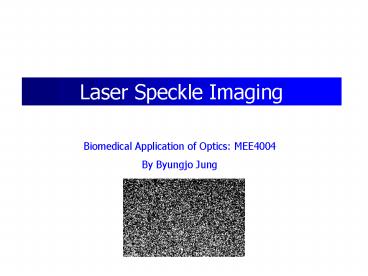Laser Speckle Imaging - PowerPoint PPT Presentation
1 / 14
Title:
Laser Speckle Imaging
Description:
optical interference effect that can be observed when objects are illuminated with ... process, burn assessment, intra-operative measurement, dermatology (psoriasis, ... – PowerPoint PPT presentation
Number of Views:2115
Avg rating:3.0/5.0
Title: Laser Speckle Imaging
1
Laser Speckle Imaging
Biomedical Application of Optics MEE4004 By
Byungjo Jung
2
What is Laser Speckle ?
- The speckle was discovered as an unexpected
phenomenon when the first lasers - were in operation. It was about the year
1960 - optical interference effect that can be
observed when objects are illuminated with - laser light. This effect is grainy in
appearance, with light and dark "speckles" - caused by constructive and destructive
interference, respectively, of scattered laser - light.
- In other words, a interference of elementary
coherent (partially coherent) beams - of radiation from many secondary light point
sources located on the rough surface - of the object.
- Laser speckle offers the possibility of
developing a full-field technique for velocity - map imaging which produces an instantaneous
map of velocities in real time - blood flow measurement in assessing
condition such as inflamation, healing - process, burn assessment, intra-operative
measurement, dermatology (psoriasis, - skin flap failure, skin irritation),
physiology
3
What is Coherent Light ?
- Coherent Light
- Light in which the phases of all electromagnetic
waves at each point on a line normal to the
direction of the the beam are identical. Coherent
light is usually monochromatic, and the most
common source of such light for practical uses is
from a laser. - Coherence is one of the unique properties of
laser light. It arises from the stimulated
emission process which provides the
amplification. Since a common stimulus triggers
the emission events which provide the amplified
light, the emitted photons are "in step" and have
a definite phase relation to each other. This
coherence is described in terms of temporal
coherence and spatial coherence, both of which
are important in producing the interference
4
What is Interference?
5
Scanning Laser Doppler Imaging (SLDI)
- Low power laser beam scans the tissue recording
measurement - spots(409664 by 64). In the tissue, the
laser light is scattered - and changes wavelength when it hits moving
blood cell (Doppler - shift).
- A fraction of the backscattered light is
detected by a photo detector - and the data is recorded and processed by
software. - Perfusion image concentration of moving blood
cell mean - velocity of these blood cells
- The concentration is related to the magnitude of
the Doppler signal - Velocity is related to the frequency shift
6
How Does Laser Speckle Imaging (LSI) Works ?
- It is important to select a laser wavelength
suitable to the tissue under observation, as it - is necessary to achieve some tissue surface
penetration with the laser light for blood flow - mapping.
- Each acquired image will display a slightly
different speckle pattern, caused by the change
of - position of moving scatterers in the area of
interest. If the time lapse between images is - known, it is possible to examine the
intensity variation of individual speckles at the
same - position in each image and calculate the
velocity of the scatterers responsible for the
variation.
7
Basic Theories Speckle Contrast
- The size of the region over which the speckle
contrast is computed must be large - enough to contain a sufficient number of
pixels to ensure accurate determination of - standard deviation mean intensity, yet not
so large that significant spatial - resolution is lost
- In practice a 5x5 or 7x7 region of pixels is
typically used to compute the speckle - contrast.
8
Raw Vs. Speckle Contrast Image
- 785 nm laser diode was expanded to illuminate a
6x4mm area of - rat cortex (skull removed, dura intact) and
the area was imaged - onto an 8-bit CCD camera
- Speckle contrast range 0 1
- 1 no blurring of the speckle pattern
- 0 the scatters are moving fast enough to
average out all of the - speckles
- darker color gt higher blood flow
9
Basic Theories Speckle Size
To ensure proper sampling of the speckle pattern,
the size of a single speckle should be
approximately equal to the size of a single pixel
in the image
F-stop the size of the aperture in a lens.
Larger the F-stops give smaller lens openings.
i.e. f2.8 gives a larger aperture (and more
exposure) than f11.
10
Basic Theories Velocity
- The velocity (in arbitrary unit) is computed
from the inverse of the correlation - time
- Theoretically, it is possible to relate the
correlation time to the absolute velocities - of the red blood cell. However, it is
difficult to do in practice because the - number of moving particles that the light
interact with and their orientation are - unknown.
- However, relative spatial and temporal
measurement of velocity can be easily - obtained from the ratios of the correlation
times. - The relative blood flow is computed by taking the
ratio of the correlation time - image at any point and a baseline image
11
Comparison Four Blood Perfusion Imager
12
Comparison between LSI and SLDI
13
Continue
14
(No Transcript)































